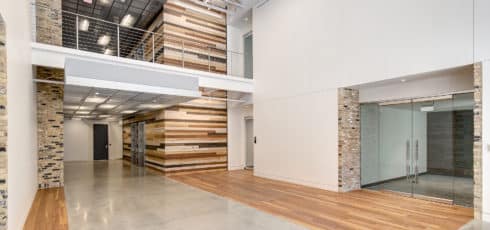This article was published in 2020 as part of our COVID-19 Resource Center series. This article will not be updated but please contact us if you have specific questions regarding the information in this article.
Whether you are a tenant or a landlord, it can be overwhelming to make strategic decisions in the face of large-scale economic change, such as with the current COVID-19 pandemic.
A question we have heard from many of our corporate clients is “how can I lower my costs in the short term?” One way for companies to lower immediate lease obligations is through a blend-and-extend lease restructure. A blend and extend can benefit both tenants and landlords, which makes it a good option for some businesses during less-than-ideal economic time periods.
Read More: AQUILA COVID-19 Austin Real Estate Resource Center
In this article, we walk through the following aspects of blend-and-extend lease restructures:
- What Is a Blend and Extend?
- How a Blend and Extend Can Help Tenants with Short-Term Rent Relief
- Why Landlords Will Consider Blend-and-Extend Negotiations
What Is a Blend and Extend?
“Blend and extend” is a phrase that refers to the concept of extending a tenant’s lease term and “blending” the current rental rate with a newly negotiated rate.
Blending and extending is generally considered a win-win situation because it can benefit both tenants and landlords.
Read Our Case Study: How AQUILA Successfully Negotiated a Blend-And-Extend Lease Negotiation for Protect America
Imagine a tenant, ABC Corp., signed a five-year lease at the top of the market in 2006, shortly before the Great Recession. The ensuing economic crisis drove vacancy rates up and rental rates down across the market. In 2009, two years before ABC Corp.’s lease expiration, the tenant needed to reduce costs. Looking for rent relief in the face of the recession, they decided to negotiate a blend-and-extend lease restructure with their landlord to negotiate a lowered rate. The landlord saw the opportunity to avoid losing a tenant at a time when market vacancy rates were high. Because of this, the blend and extend was a popular solution for many tenants during this time, as it benefitted all parties involved.
As we enter another period of economic uncertainty caused by the COVID-19 pandemic, this may once again become a critical strategy used by tenants to solve short-term financial strains.
How a Blend and Extend Can Help Tenants with Short-Term Rent Relief
A blend and extend may be a good solution for your company if you:
- Are seeking short-term rent relief
- Have less than two years remaining on your lease
- Feel relatively comfortable you will want to remain in your current space (or downsize into a portion of your current space)
In exchange for extending your lease commitment, your landlord might be willing to offer up-front abated rent, as well as a tenant improvement (TI) allowance should you need to perform any work in your space to make it suitable for you long-term. The abated (or free) rent period could solve your immediate cost savings need, while the TI could be especially helpful if you choose to downsize and need to revamp your existing space.
It’s important to note that your company’s credit will have a significant impact on a landlord’s amenability to these negotiations.
To learn more about what a landlord may want to see before agreeing to a lease restructure, read our article What You Need Prepared Before You Approach Your Landlord for Rent Relief Negotiations.
Why Landlords Will Consider Blend-and-Extend Negotiations
In the face of economic uncertainty, a blend and extend can benefit a landlord in a number of ways.
By extending your lease, they avoid vacancies in their building. Vacancy can be expensive for landlords in any market, but at the bottom of the commercial real estate cycle, landlords are especially inclined to avoid unnecessary vacancies.
Read Next: 3 Potential Rent Relief Structures to Talk to Your Broker About Amidst COVID-19
Given the uncertainty of the current market (and the fact that there are 4.5 million square feet under construction that are not accounted for with leases), we may see some landlords start to get aggressive in the short term in order to get ahead of the curve and limit their future exposure.
One of the most common issues faced by landlords is a property or space being left vacant for an extended period of time. When this happens, the landlord not only misses out on income from the space, but has to spend time marketing the space and chasing leads that may not end in a signed lease.”
– Seth Stuart, 3 Problems A Landlord Broker Can Help You Solve
As a tenant, it is important you pursue all options and truly explore the idea that you may not renew your current lease. This will provide you leverage in negotiating your blend and extend.
Going through the site selection process and considering other viable options can give you the best chance to gain concessions since you have ‘one foot out the door.’”
– Taylor McHargue, 3 Reasons to Use a Tenant Representation Broker for Your Lease Renewal
A savvy tenant representation broker will be able to prove to your landlord the increased risk and expenses they are likely to incur by allowing you to leave and putting your space back on the market.
Not only will they risk the space sitting vacant for a number of months (a likely outcome while the market is in a downturn and experiencing high vacancy and soft tenant demand), but the concessions demanded by a new tenant are likely to be far larger than what it would take to renew you as the existing tenant. New tenants typically require much larger TI allowances to build out their new space, and they will likely request several months of free rent to help offset any moving or startup costs. That’s potentially several months of free rent on top of the months the space sat vacant with no rental income coming in.
Through this, your tenant representation broker should be able to quantify the potential savings your landlord will achieve by agreeing to a blend and extend today. This is especially relevant if the landlord has debt on the building and needs to be able to continue making their own debt payments using this rental stream.
Finally, landlords know banks will value their property based on tenancy. Higher vacancy rates result in a lower value. If the landlord is hoping to secure a new loan or refinance, it is important to maintain occupancy within the building.
Read Next: How the Paycheck Protection Program Can Help Companies Cover Office Rent
If you have questions about blend-and-extend lease amendments or want to know if it’s the right choice for you, schedule a consultation with one of our tenant representation brokers today.
Or, to continue learning about commercial real estate trends in the light of COVID-19, please visit the AQUILA COVID-19 Austin Real Estate Resource Center.











